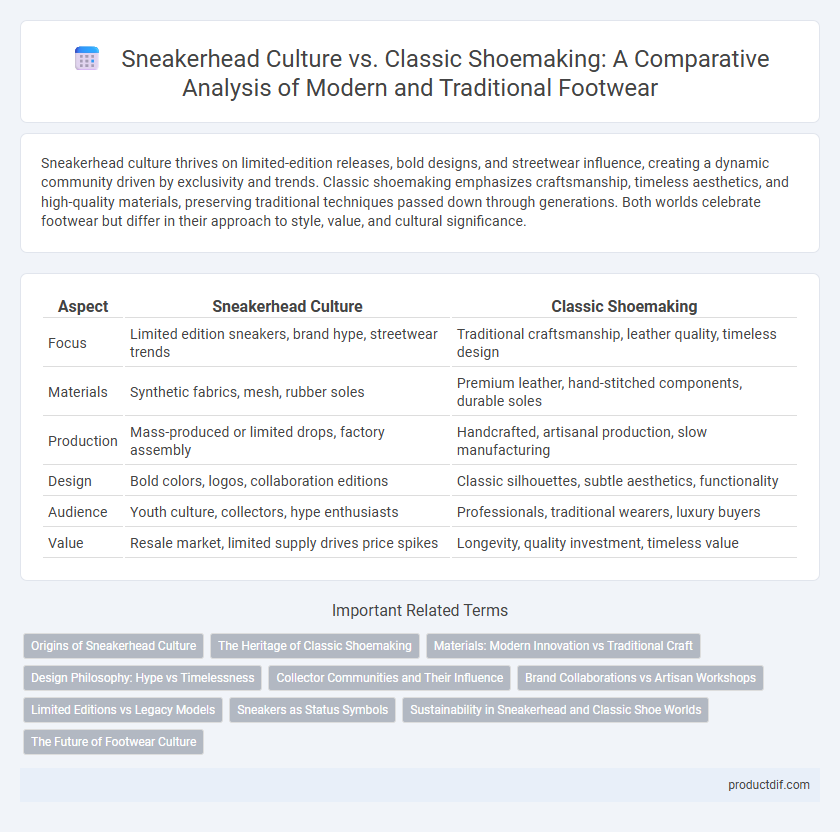Sneakerhead culture thrives on limited-edition releases, bold designs, and streetwear influence, creating a dynamic community driven by exclusivity and trends. Classic shoemaking emphasizes craftsmanship, timeless aesthetics, and high-quality materials, preserving traditional techniques passed down through generations. Both worlds celebrate footwear but differ in their approach to style, value, and cultural significance.
Table of Comparison
| Aspect | Sneakerhead Culture | Classic Shoemaking |
|---|---|---|
| Focus | Limited edition sneakers, brand hype, streetwear trends | Traditional craftsmanship, leather quality, timeless design |
| Materials | Synthetic fabrics, mesh, rubber soles | Premium leather, hand-stitched components, durable soles |
| Production | Mass-produced or limited drops, factory assembly | Handcrafted, artisanal production, slow manufacturing |
| Design | Bold colors, logos, collaboration editions | Classic silhouettes, subtle aesthetics, functionality |
| Audience | Youth culture, collectors, hype enthusiasts | Professionals, traditional wearers, luxury buyers |
| Value | Resale market, limited supply drives price spikes | Longevity, quality investment, timeless value |
Origins of Sneakerhead Culture
Sneakerhead culture originated in the late 1970s and early 1980s, rooted in basketball and hip-hop communities where limited-edition sneakers became symbols of status and identity. This subculture emphasizes rare releases, brand collaborations, and sneaker customization, contrasting sharply with the traditional craftsmanship and timeless designs of classic shoemaking. Collectors and enthusiasts value storytelling behind each sneaker model, fueling a vibrant market that blends fashion, art, and athletic heritage.
The Heritage of Classic Shoemaking
Classic shoemaking heritage emphasizes artisanal craftsmanship, premium leather, and timeless design passed down through generations, preserving durability and elegance. Sneakerhead culture thrives on limited editions, bold aesthetics, and streetwear influence, often prioritizing trend-driven appeal over traditional methods. The enduring legacy of classic shoemaking continues to define quality and refinement in footwear, contrasting with the fast-paced, collectible nature of sneaker culture.
Materials: Modern Innovation vs Traditional Craft
Sneakerhead culture thrives on cutting-edge materials like engineered mesh, synthetic leathers, and advanced cushioning foams designed for performance and style. Classic shoemaking emphasizes traditional materials such as full-grain leather, hand-stitched soles, and natural rubber, highlighting durability and timeless craftsmanship. The contrast reflects a shift from artisanal techniques to innovative fabric technology, catering to different consumer values in the footwear market.
Design Philosophy: Hype vs Timelessness
Sneakerhead culture emphasizes bold, innovative designs driven by trends, collaborations, and limited releases that fuel consumer excitement and exclusivity. Classic shoemaking prioritizes timeless craftsmanship, using premium materials and traditional techniques to create durable footwear with enduring aesthetic appeal. The design philosophy contrasts instant hype with enduring elegance, reflecting differing values in production and cultural significance.
Collector Communities and Their Influence
Sneakerhead culture thrives on limited-edition releases, collaborations, and streetwear influence, cultivating vibrant collector communities that fuel demand and hype cycles. Classic shoemaking emphasizes craftsmanship, heritage, and timeless design, attracting collectors who value artisanal techniques and historical significance. Both communities drive market trends and resale value but differ in their appreciation of innovation versus tradition in footwear.
Brand Collaborations vs Artisan Workshops
Sneakerhead culture thrives on high-profile brand collaborations that merge streetwear aesthetics with limited-edition exclusivity, driving massive hype and resale value. In contrast, classic shoemaking emphasizes artisan workshops where skilled craftsmen prioritize quality materials and traditional techniques, ensuring durability and timeless elegance. Both approaches influence footwear trends, yet brand collaborations focus on innovation and mass appeal, while artisan workshops uphold heritage and meticulous craftsmanship.
Limited Editions vs Legacy Models
Sneakerhead culture thrives on limited editions, driving demand through exclusive drops and collaborations that emphasize rarity and contemporary design. Classic shoemaking focuses on legacy models, preserving traditional craftsmanship and timeless aesthetics valued for durability and heritage. The contrast highlights a market split between transient hype-driven collections and enduring, meticulously crafted footwear icons.
Sneakers as Status Symbols
Sneakerhead culture transforms sneakers into coveted status symbols through exclusive releases, limited editions, and vibrant collaborations, fueling a global market driven by rarity and hype. In contrast, classic shoemaking emphasizes timeless craftsmanship, premium materials, and heritage, appealing to those who value tradition over trend. Sneakers embody modern status by blending fashion, identity, and social capital, while classic shoes symbolize enduring elegance and artisanal legacy.
Sustainability in Sneakerhead and Classic Shoe Worlds
Sneakerhead culture emphasizes sustainable materials such as recycled plastics and organic cotton, driving innovation in eco-friendly sneaker production and reducing landfill waste. Classic shoemaking prioritizes durability with high-quality leathers and traditional craftsmanship, promoting longevity and repairability to minimize environmental impact. Both worlds contribute uniquely to sustainability by balancing mass-market trends with artisanal practices, fostering a growing emphasis on ethical sourcing and circular fashion.
The Future of Footwear Culture
Sneakerhead culture drives innovation with limited-edition releases and tech-infused designs, reshaping footwear's identity through digital communities and resale markets. Classic shoemaking preserves artisanal craftsmanship, emphasizing durability, bespoke tailoring, and timeless aesthetics rooted in heritage. The future of footwear culture merges cutting-edge technology with traditional methods, fostering sustainable practices and personalized experiences that appeal to both collectors and connoisseurs.
Sneakerhead culture vs Classic shoemaking Infographic

 productdif.com
productdif.com